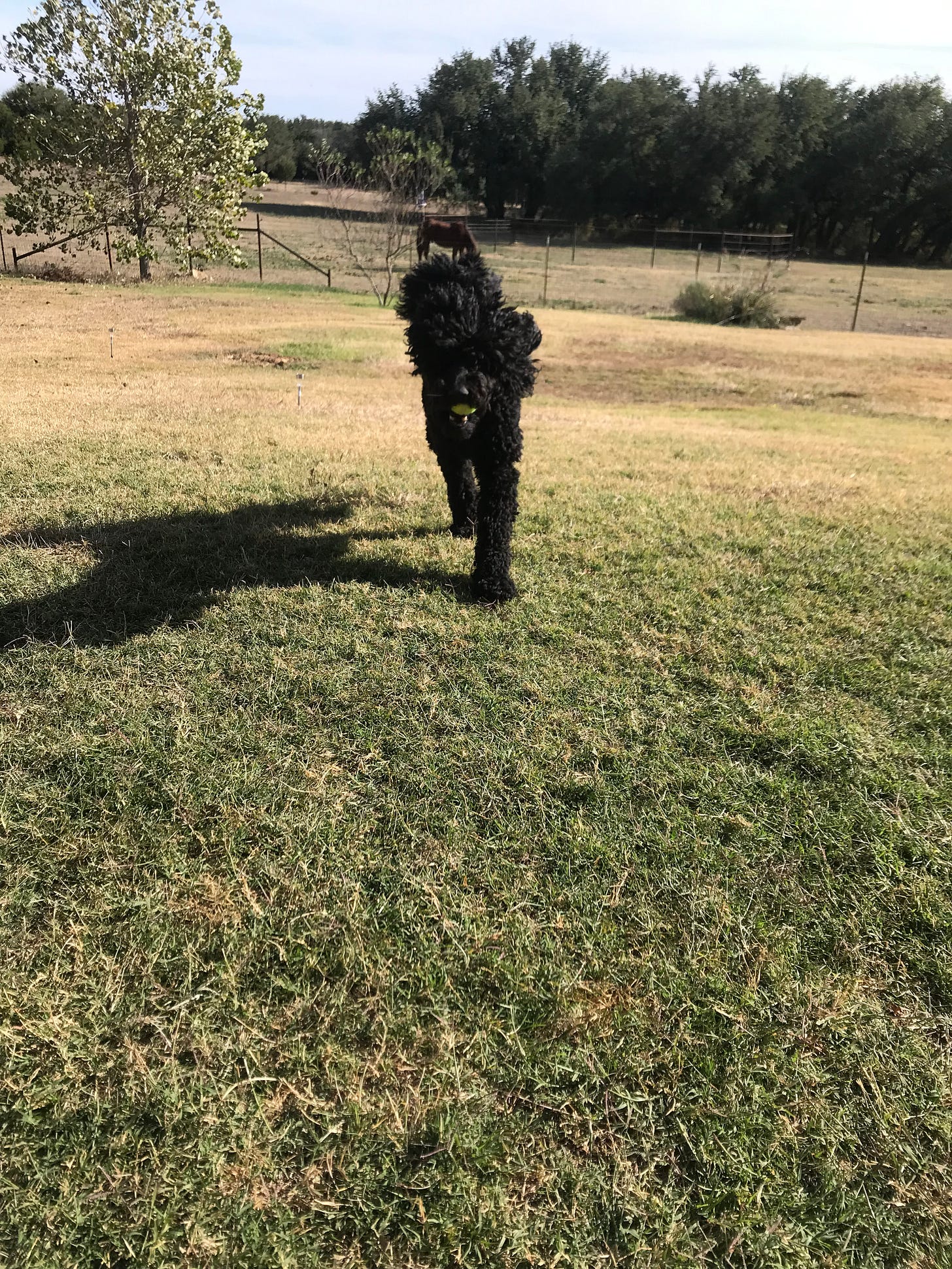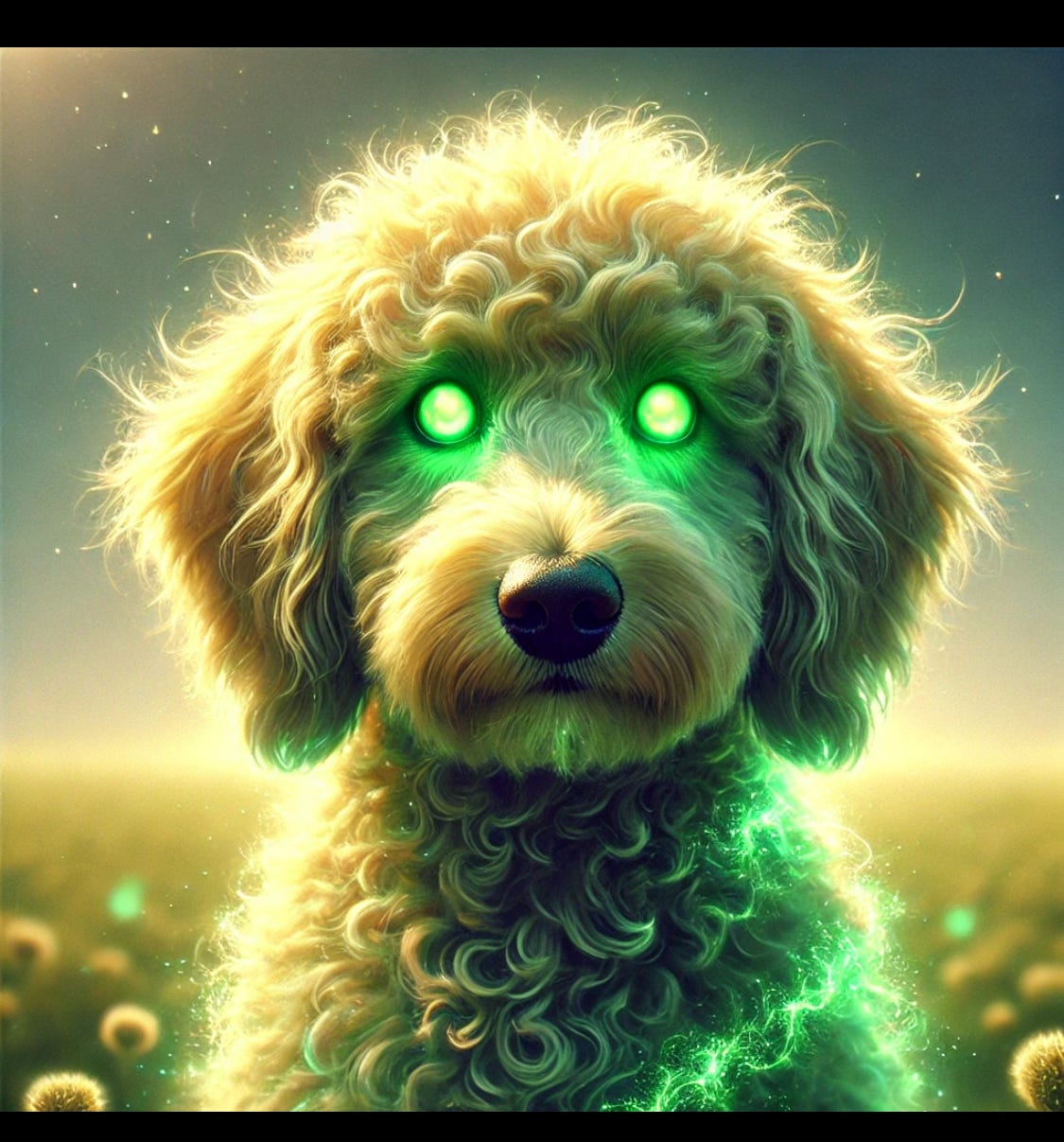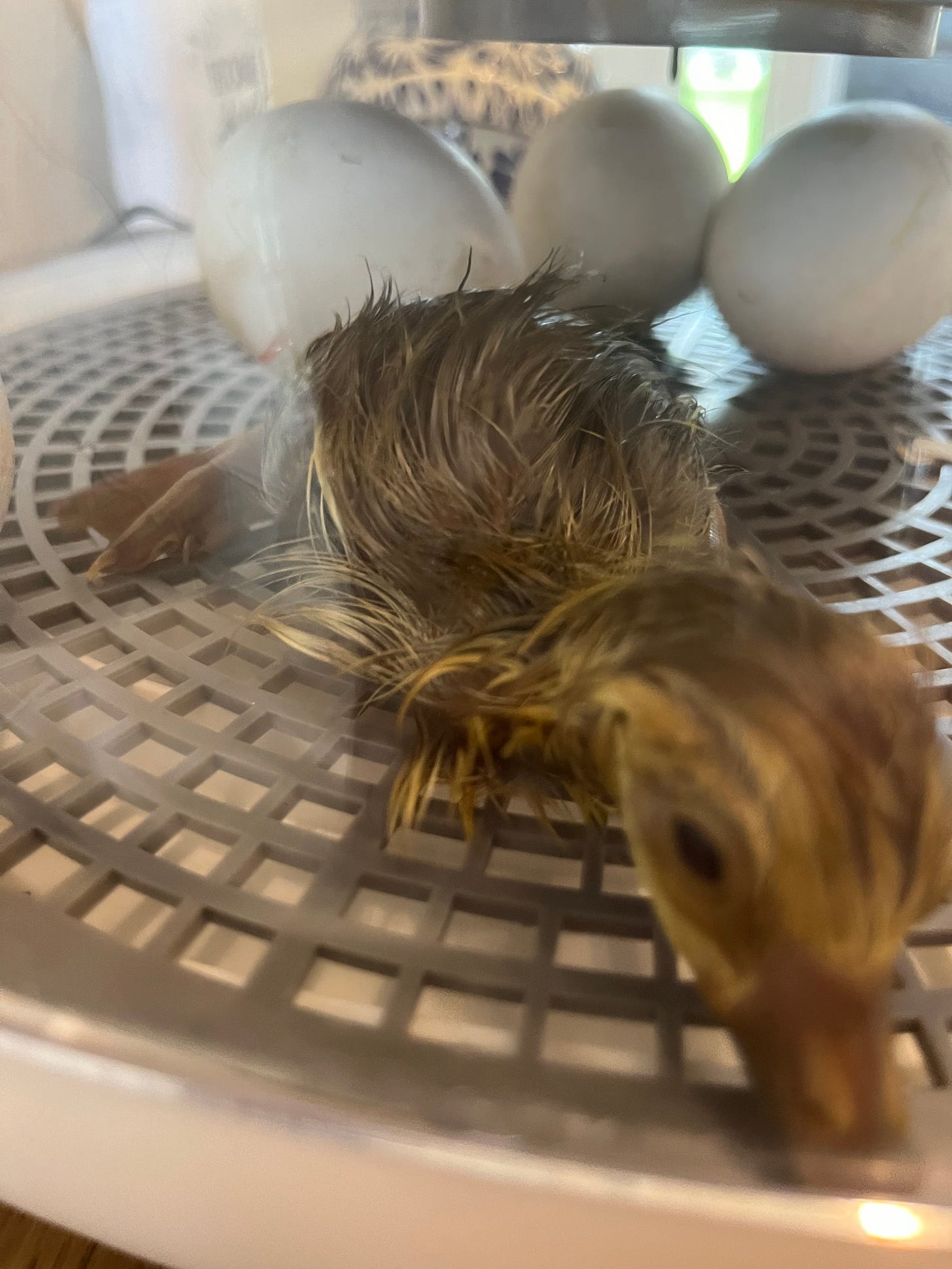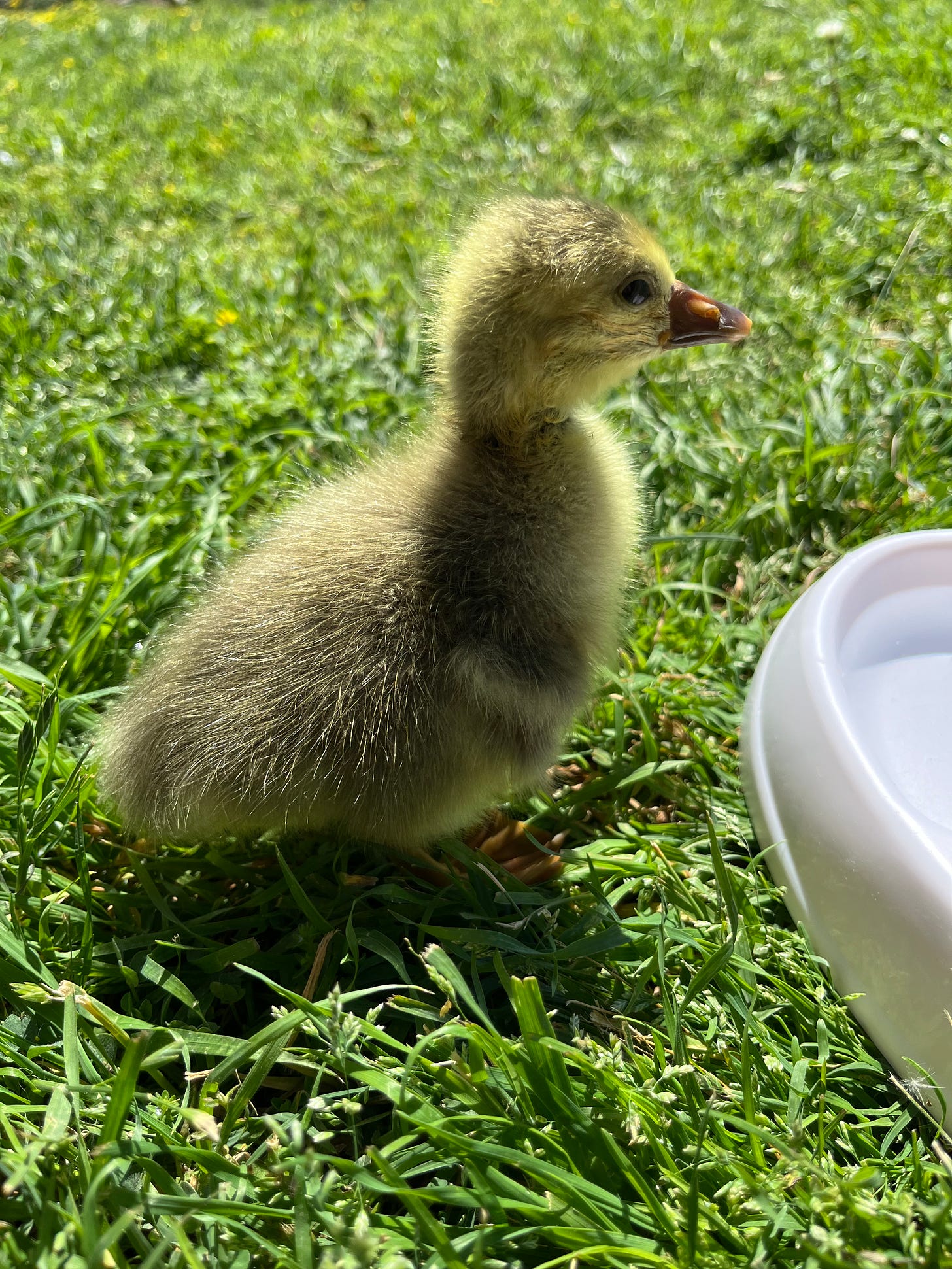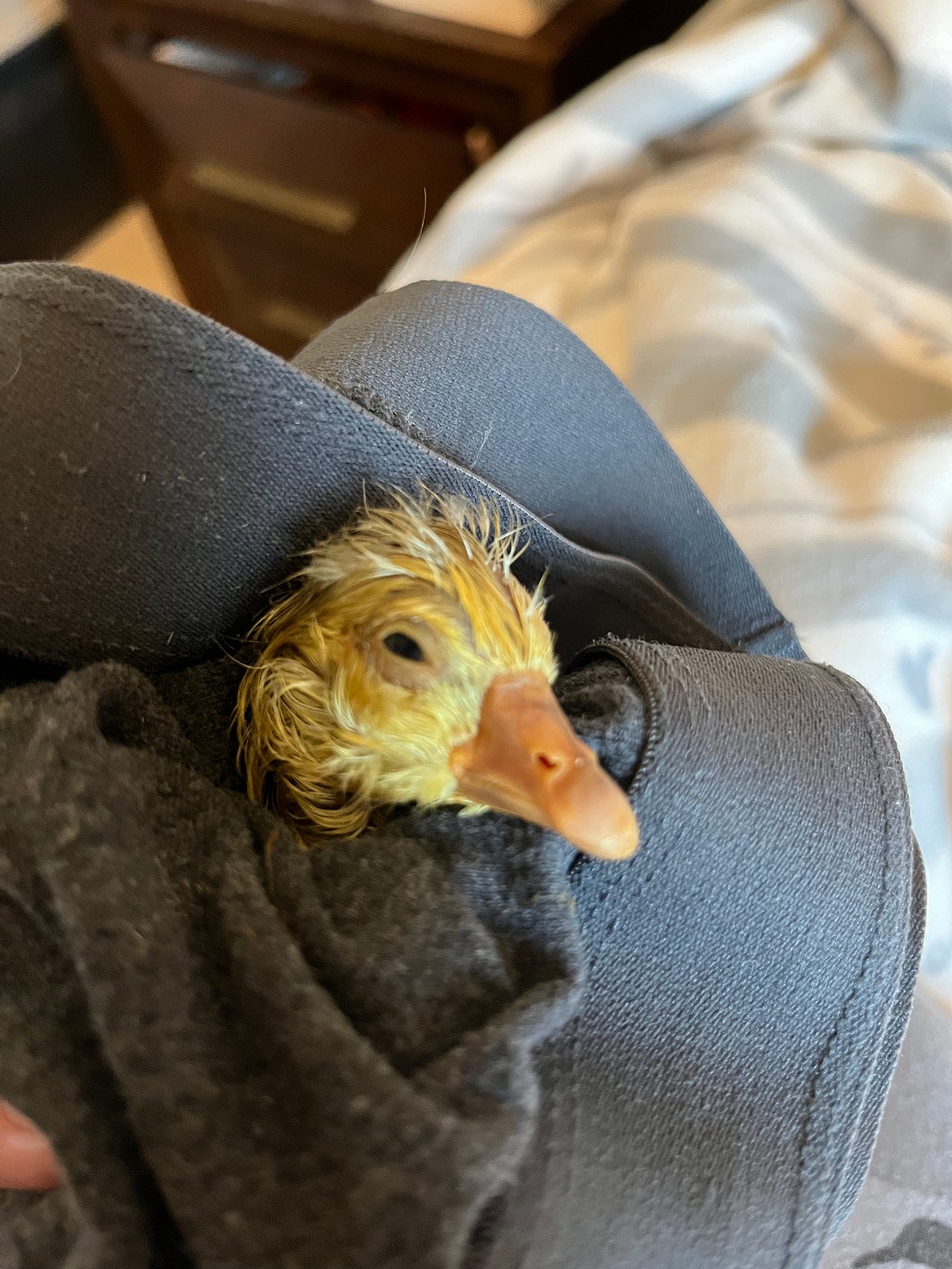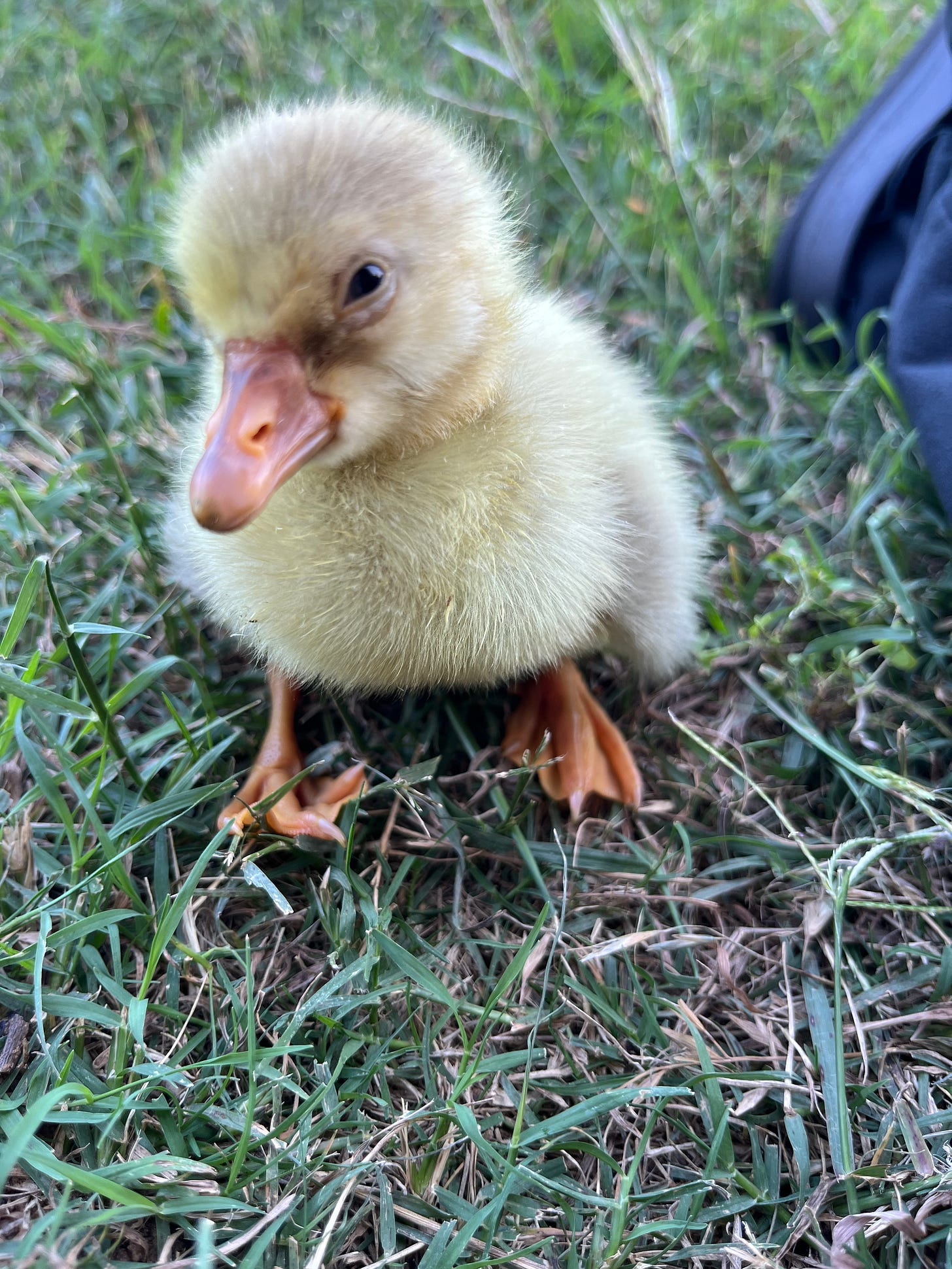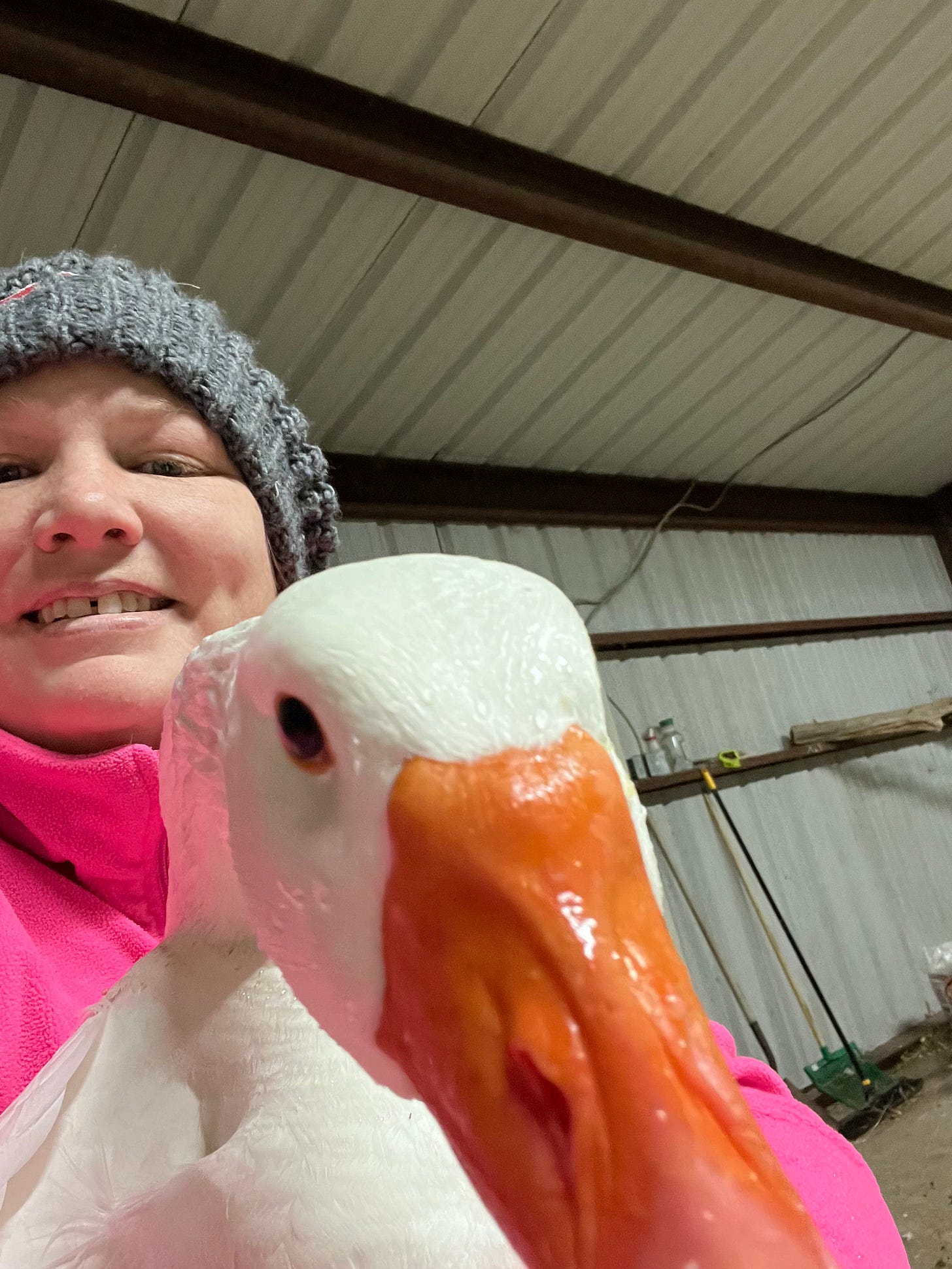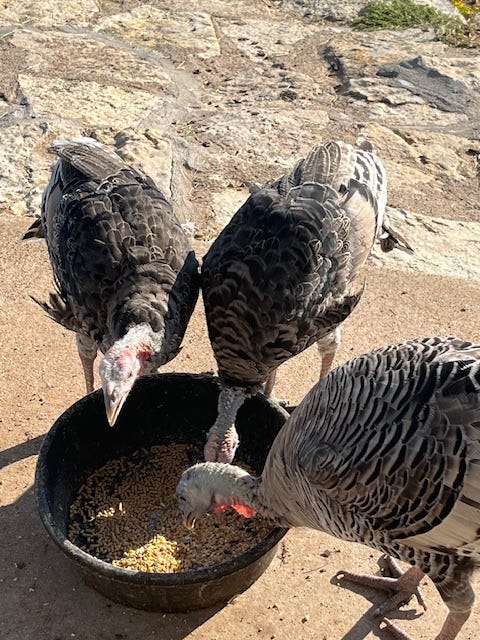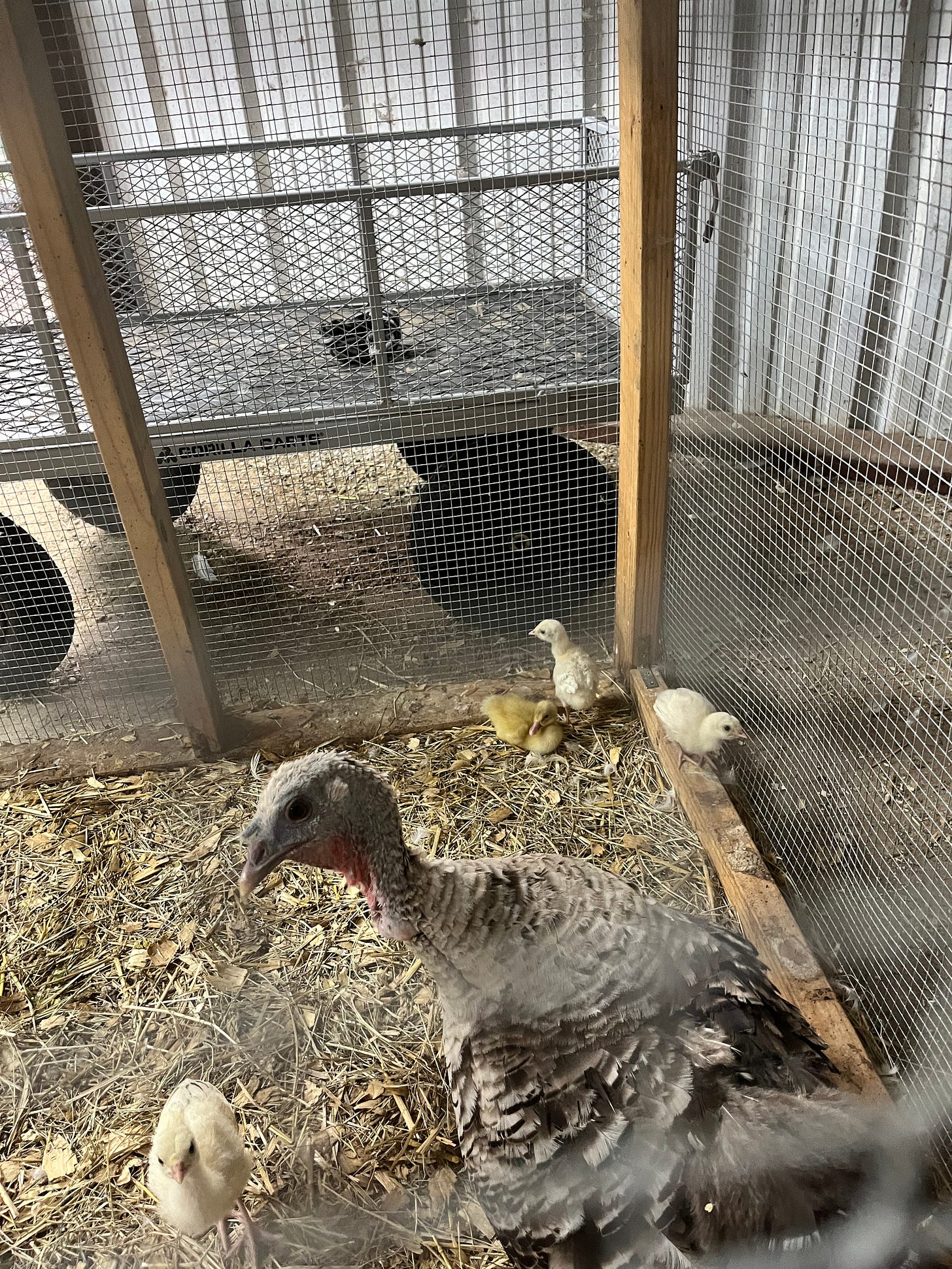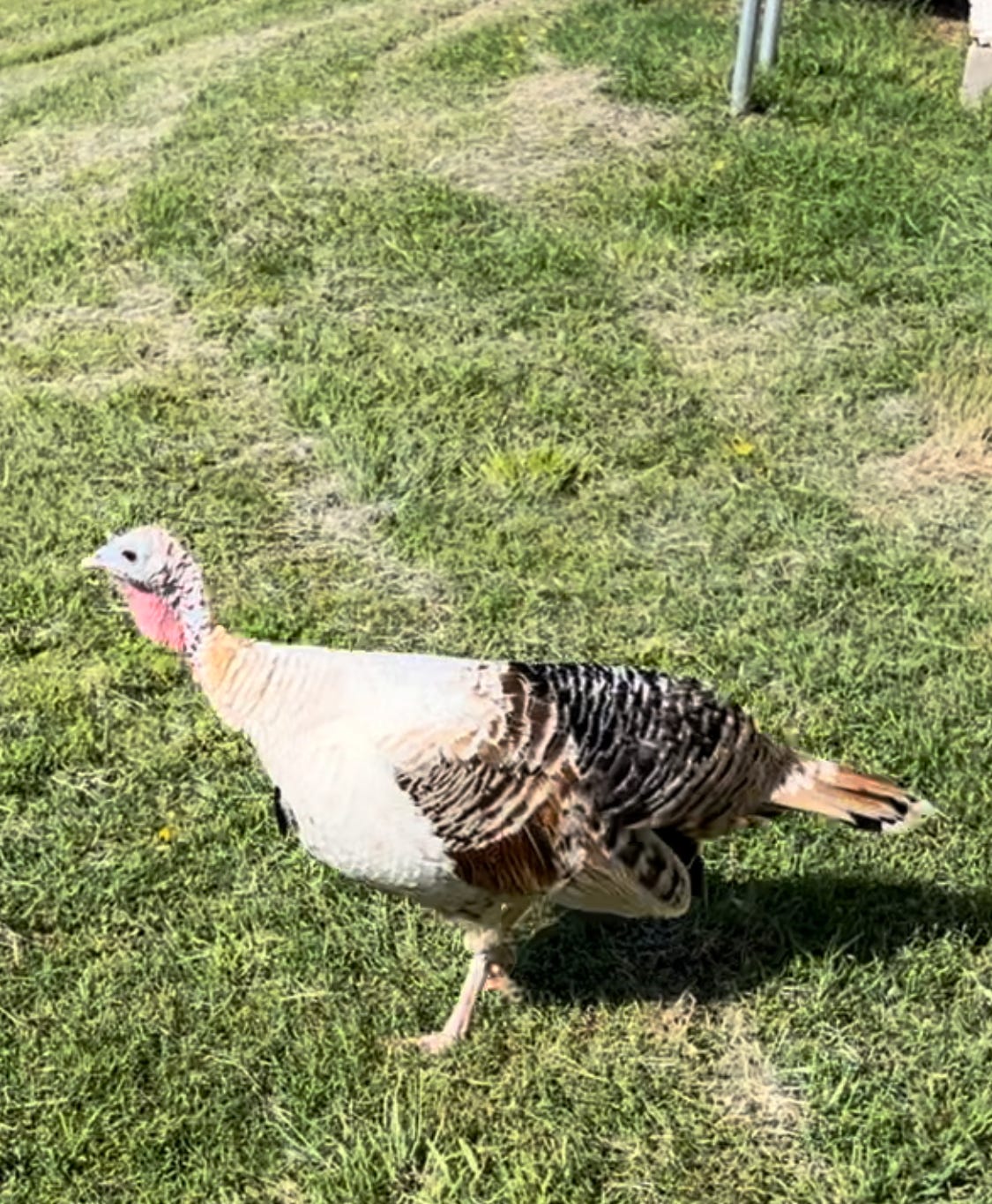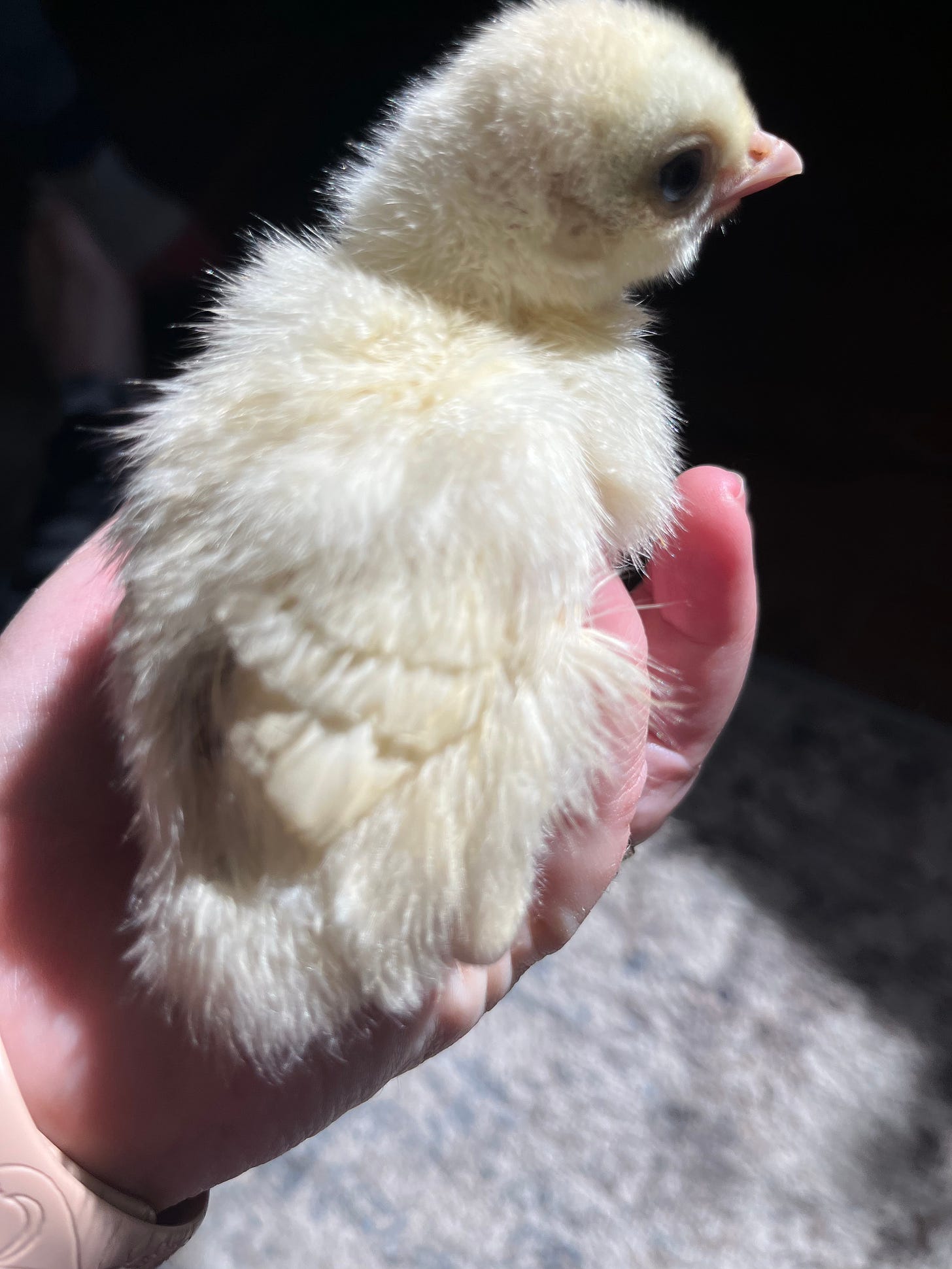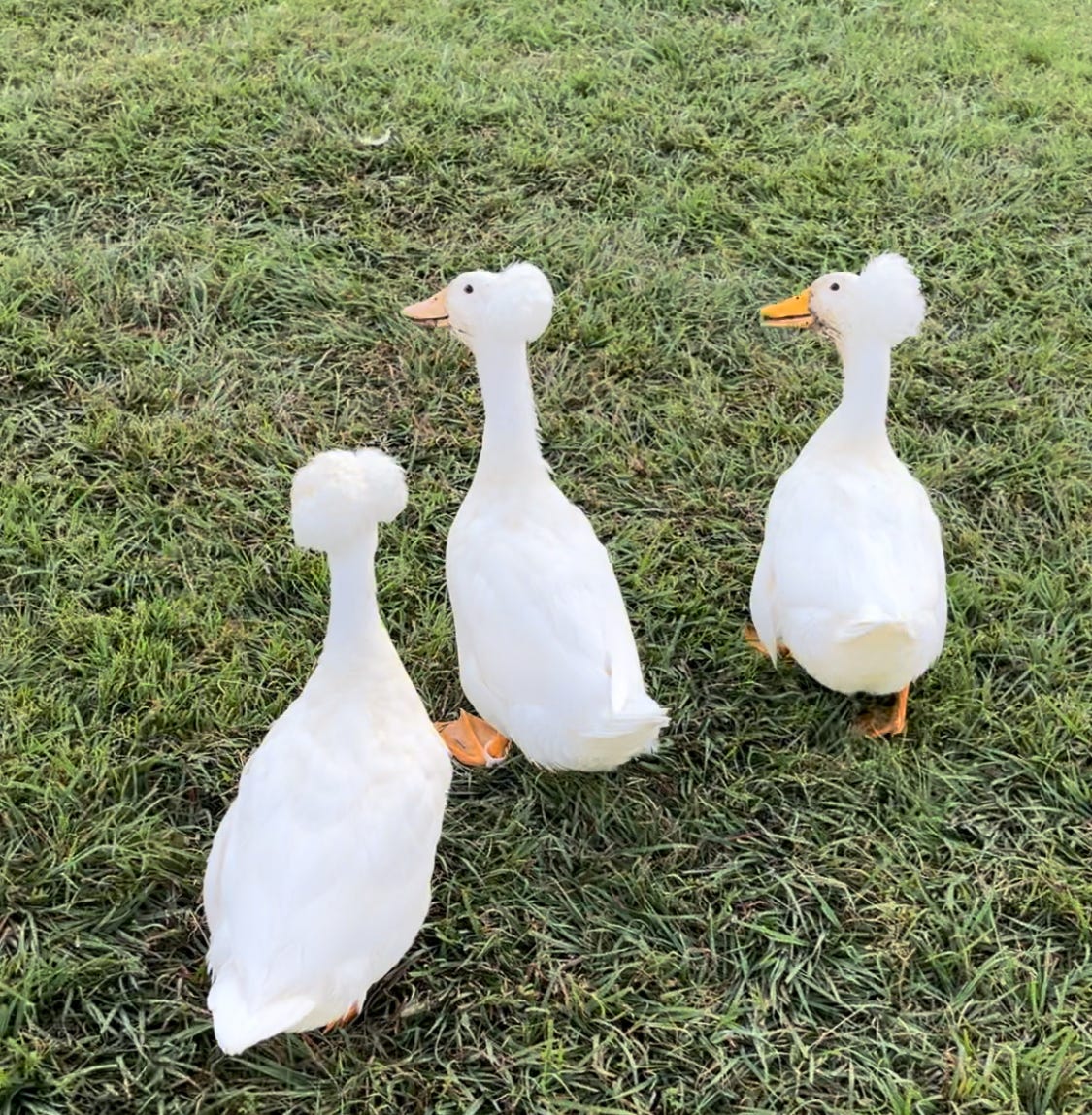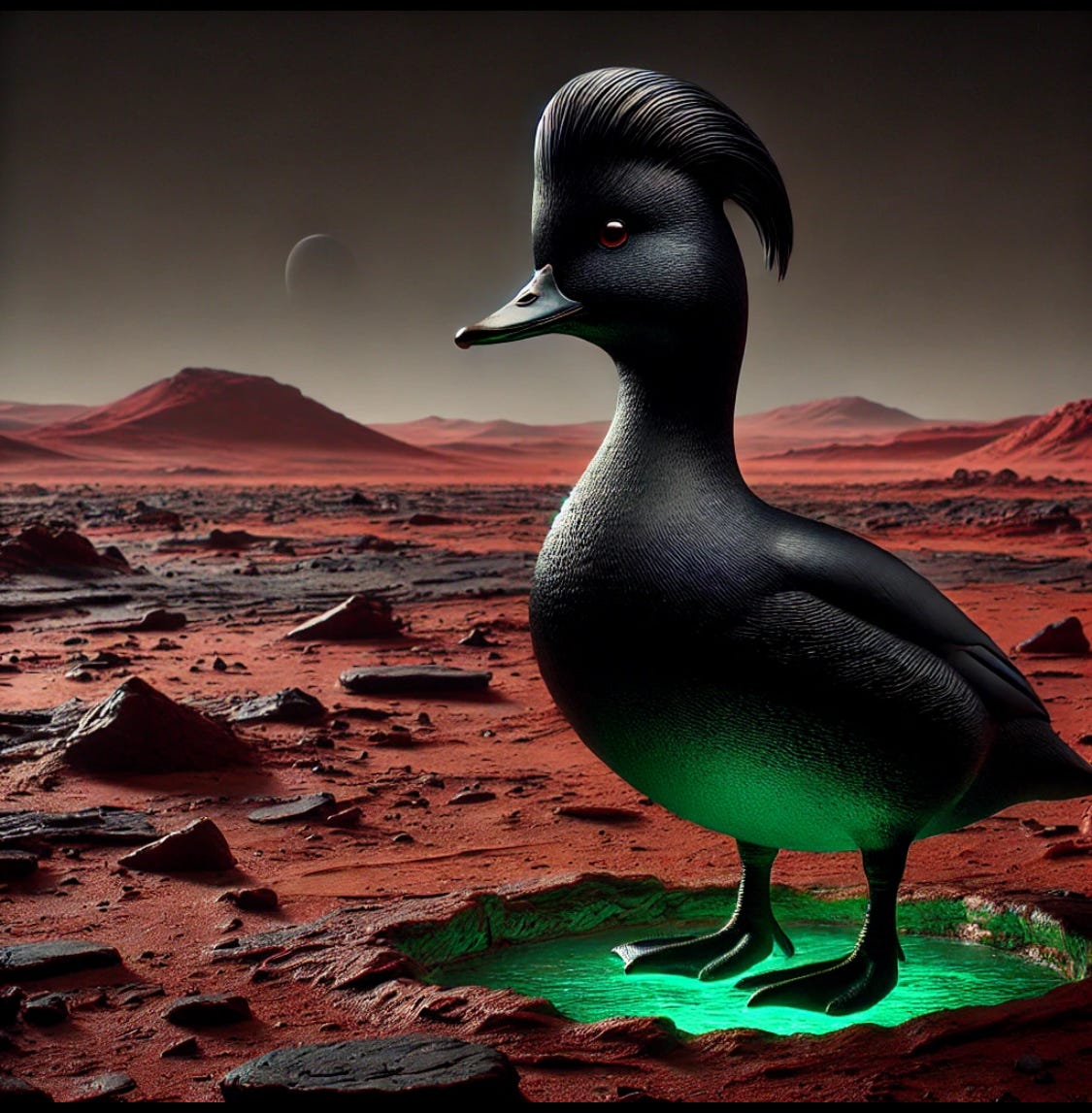Pure bre(a)d
Breeds and varieties, colors and genes
Ok, it’s time. Time for a complete rant about my knowledge, research and (ever growing) experience in the areas of bird colors and genetics. I have a project going on (17 months and counting at post date) that I can generally attribute to sex-linked colors in my Heritage turkeys, ducks and geese. Specifically, I broke it down to each of my three types of birds…details to follow and feel free to scroll to your bird of interest. For my project, I strive to keep birds in my breeding program and on my property that align with my needs and goals, while selling, trading away or blessing others with birds that do not align. Notable exceptions (usually for health reasons) are allowed to remain, in a state of semi or permanent retirement:
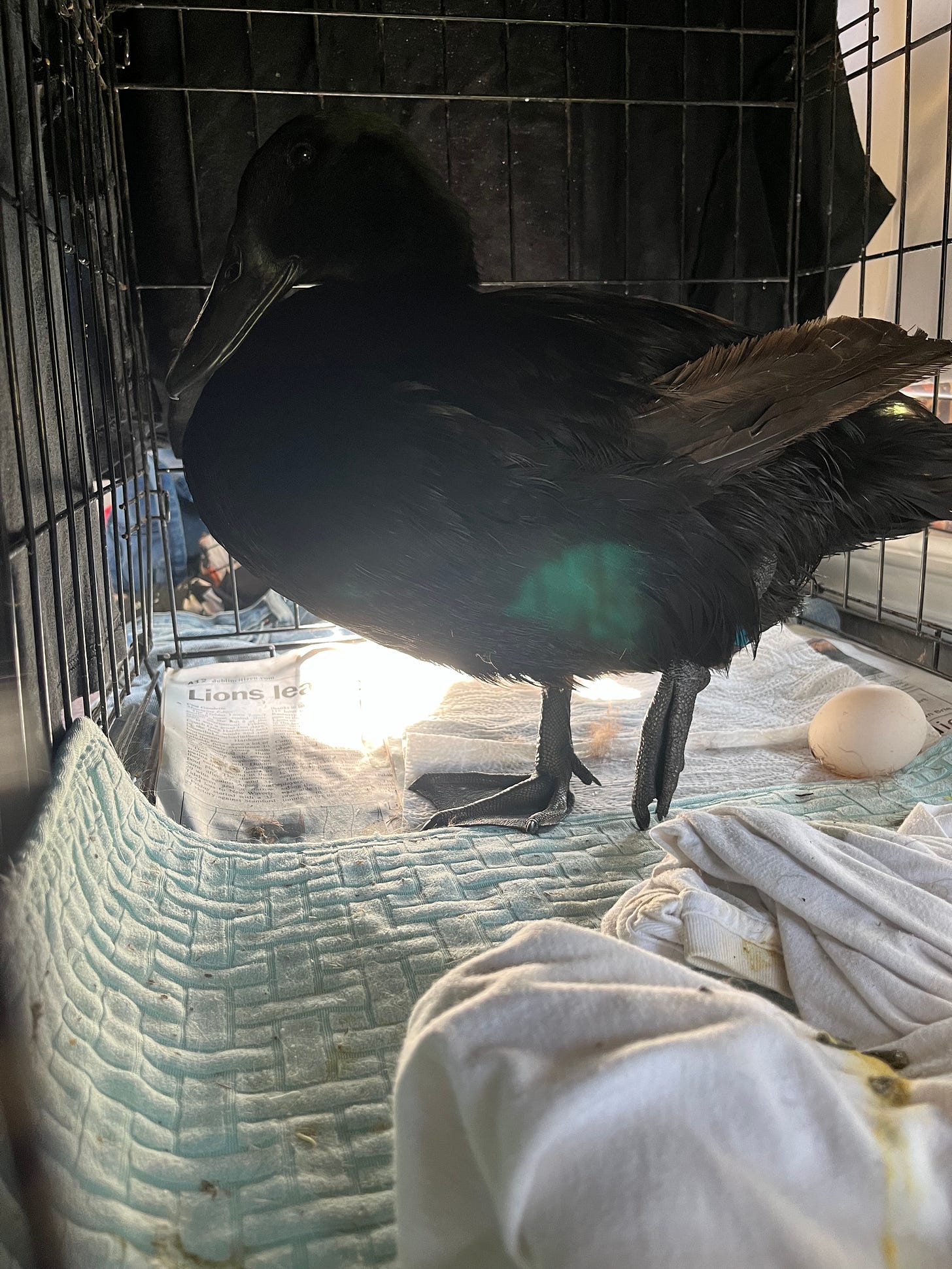
Inevitably, while attempting to rehome some birds, I get the question, “But are they pure?” and rather than launch into my usual long-winded tirade about the difference between breeds, varieties, breed standards and genetics, I figured I would hack it out on the keyboard and refer these people to this post (but probably not). There is a concept of “breed” that people have in their mind about animals that is tied up with and confused with breed standards, registries and ‘papers’. A breed standard is an agreed upon set of characteristics that defines what an organization considers to be a good specimen of something, among them (but not limited to) coat/feather color. Specimens that fit most of these characteristics can be registered with this organization (‘papered’) and shown, bred, etc. in relation to this organization. This concept works well for example, for dogs and horses where for decades or maybe more, registered animals (‘purebred’) are mated and their offspring produce more registered animals that hopefully also adhere to the standards. From personal experience, my registered Tennessee Walking Horse mare, Kimber, was bred to a registered TWH stallion and her foal was then dna tested to match their dna in order to be registered himself. The dna requirement for TWHs is relatively recent, since 2007 and requires a dna bank and database maintained by the registry organization, the TWHBEA. Before that, the person filing the paperwork was on a scout’s honor to make sure the registered animal on paper and in reality was one and the same. With dogs, even though I own a ‘purebred’ Standard Poodle, I have never been interested in breeding or papers, but I imagine it’s a similar type process, especially with the increasing ease of dna collection, banking and database capabilities.
Someone could show up from another country with a registered animal or from Mars, for example, and attempt to get their animal qualified for an organization here. For an other-papered animal, it would involve subjecting the animal to scrutiny, shows and tests to see how closely it resembles the standard. For the Martian, however, this would be near impossible since the assumption of breed standards is that once a registry has been created, only the offspring from this closed group of animals will be ‘purebred’ and close to the standard. Martian might have a wonderful specimen, but Earthlings will be extremely reluctant to accept that it didn’t come from their registry’s lines and therefore couldn’t fit the breed standard. The Martian then goes and renames his dog a Martydoodle and has an immediate following wanting glowing, floofy dogs:
On the subject of doodle dogs, they are my preferred example of an F1 hybrid. This “first line” generation is a cross between a poodle and something else and has the typical -doodle look (color, fluffy coat associated with Poodle breed standards). This offspring can be bred back to a parent, known as “line-breeding”, breeding back up the line. It can also be bred to other F1s, but the resulting offspring will not necessarily look like the parents, and in the case of doodles, will probably look far off enough to be considered an ugly mutt. A lot of people have bought a pair of fluffydoodles and bred them and omg-what the heck happened? without realizing the genes at play or being committed enough to research and work towards a goal while understanding the implications. Not that I am against hybridizing at all - in fact, I am likely more pro- than anti- hybrids in several applications. Hybrids can create something new with (hopefully) a set of useful characteristics, increase health and diversity and even prevent extinction. Useful hybrids have been created that have sterile offspring but serve a purpose - most famous are mules (donkey dad, horse mom) and hinnies (horse dad, donkey mom), although the preference for mules is overwhelming because of the useful characteristics they bring over hinnies. This is also a case for duck hybrids, Muscovy ducks crossed with Mallard-based ducks are called Moulard or Hinny ducks and are used for table birds (body weight of the Muscovy but added fat and flavor from the mallard). Their offspring are sterile, even though the females can lay eggs that won’t develop. Muscovies come in a nice variety of colors, but are excluded from my own color project because of the sterile offspring issue. My Mallard-based selections are also limited to what I have for certain reasons, which I’ll detail in the duck section below. For now, let’s start with the lowest-hanging fruit,
Pilgrim geese
I chose these geese to guard my ducks and other flock members, because of their medium size, diet of mainly grasses, but most of all their auto-sexing. This means that at hatch, you can tell by color if the goslings are male or female. This ability is incredibly useful for the flock manager and 100% accurate. The Cotton Patch goose is the only other American auto sexing goose and comes in similar color patterns. Both of these breeds have a fascinating history that forms part of the fabric of American history and are disappearing from American farms (links below if you’re interested).
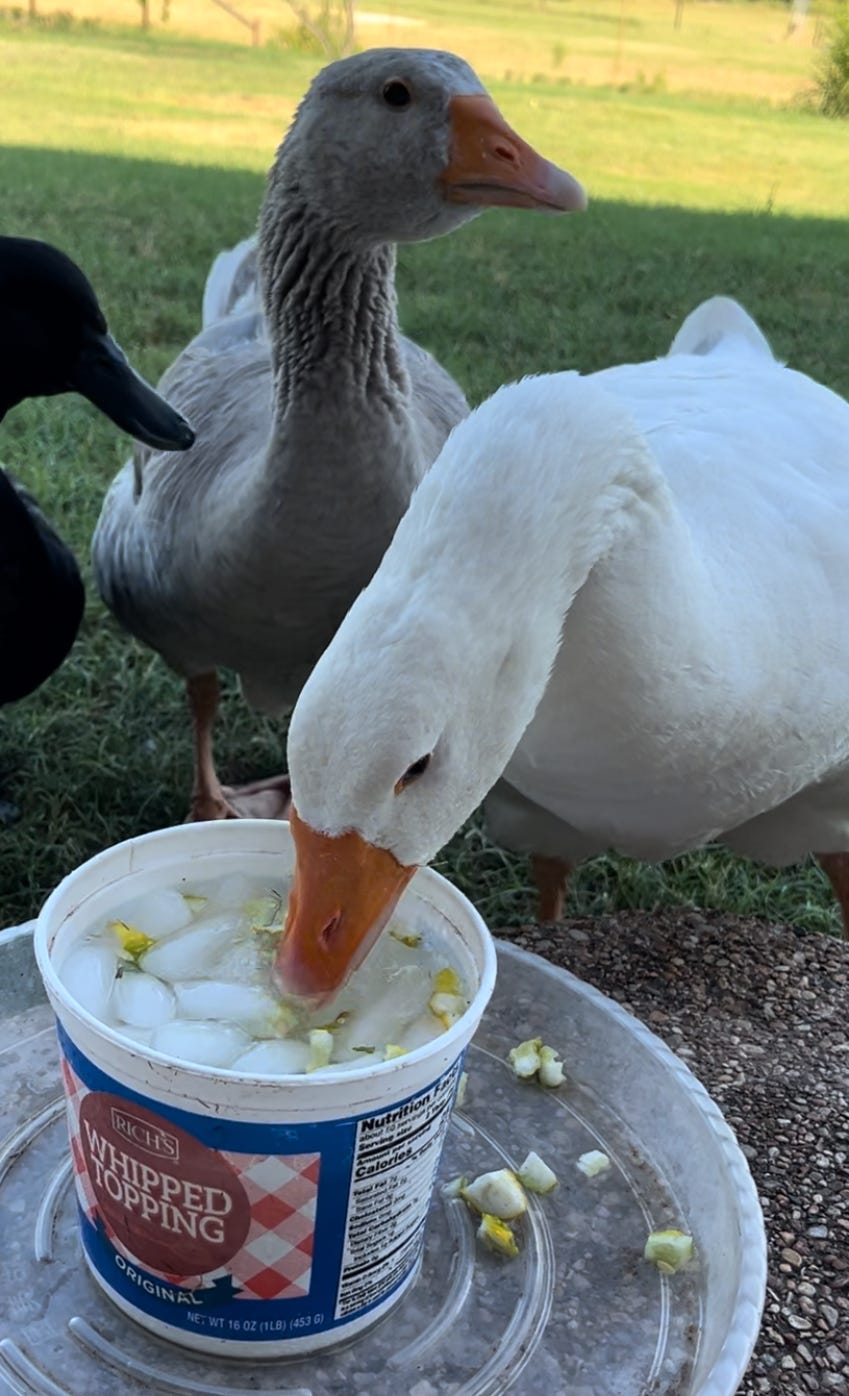
Obviously, the Pilgrims make it easy for me so there’s not a lot of detail about that here. If I were to expand beyond the pair I currently have, I would either line breed daughters back to my gander, or find a reputable and real Pilgrim breeder to get females from. I love my gander, Lorenzo, but one gander with his shenanigans is enough for our homestead, especially during the spring! Some “Pilgrim” geese are not actually Pilgrims and therefore are not reliable to auto sex, buyer beware.
The geese were my latest flock addition when I kept losing ducklings inside my barn at night. I discovered (and dealt with) the snake that was causing the losses and built a hardware mesh box that my babies sleep in until they’re too big for snakes to be interested in. I also have a minnow trap baited with a fresh egg (if a duck egg gets too dirty, this is where it goes)-snake gets inside, eats the egg, then can’t get out. I will say that during the day, the geese make excellent alarm systems for anything they think isn’t right or shouldn’t be there…which isn’t always foreign. During the spring, my gander is protective of his goose, their nest and the barn in general. He chases other birds, my family members and even charges my gelding. Occasionally I have the need to have a staff meeting with Lorenzo, which involves grasping him by his neck and swinging him under my left arm, Heisman trophy style. This allows me to have discussions with him about his behavior, poor choices and future prospects. The geese are quite intelligent and a beautiful addition to any farm landscape, I never regret having added them to my flock, and always finish the staff meetings with kisses on top of his head.
Heritage Turkeys
I won’t go (again) into all of the deets about the turkeys in this post, only to specify that I have heritage turkeys in several varieties. Heritage breeds/varieties are not wild (Eastern, Rio Grande) but are not Broad-Breasted types created and grown for factory level production. Hatcheries and feed stores will often have BB poults for sale, but I think they should come with a warning label as they have notoriously short and laborious lifespans. For all of these, the ‘breed’ is Turkey and the variety can be described by their colors. My project involves a select few of these color varieties, especially when it comes to sex linked poults by color.
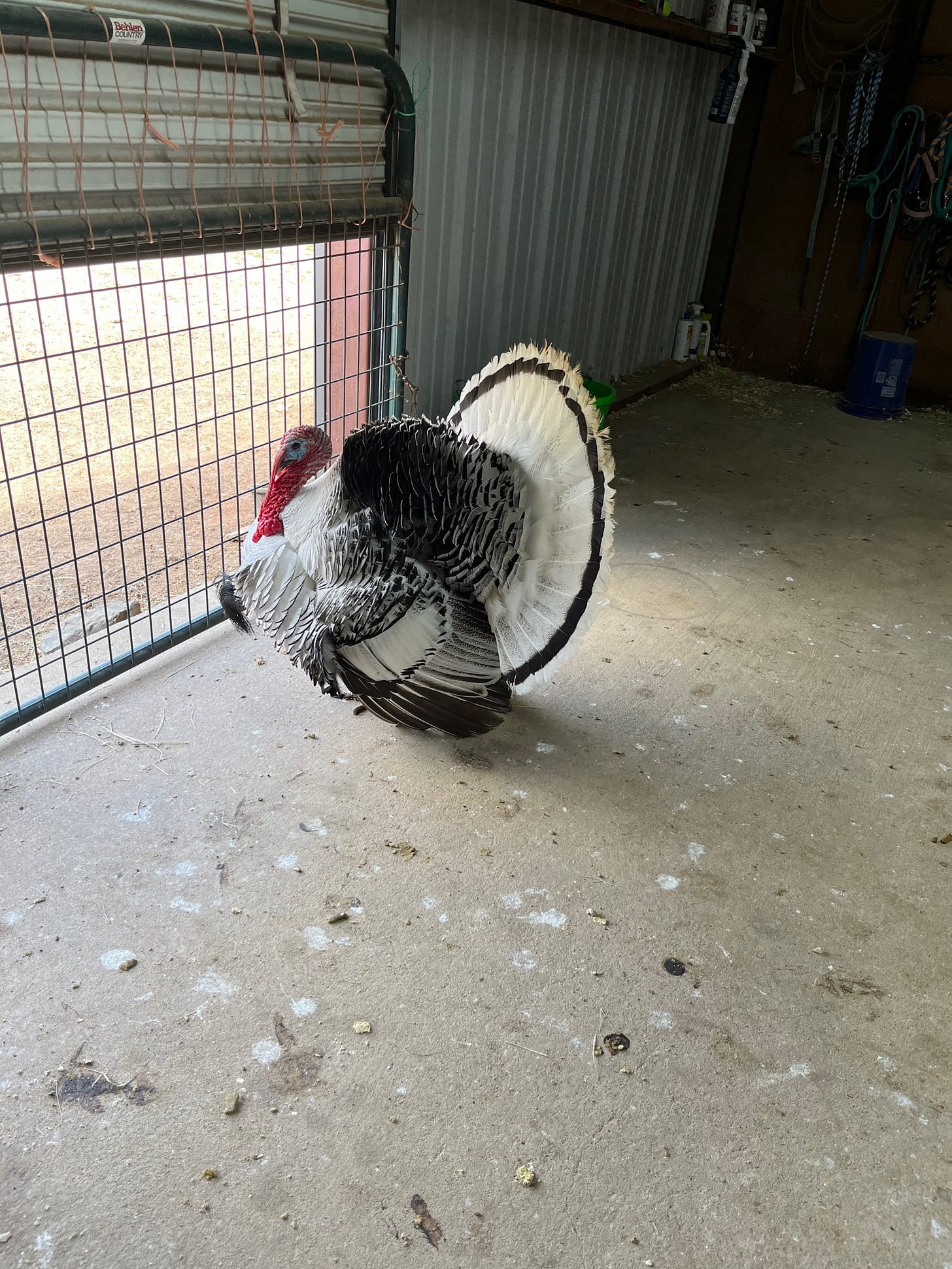
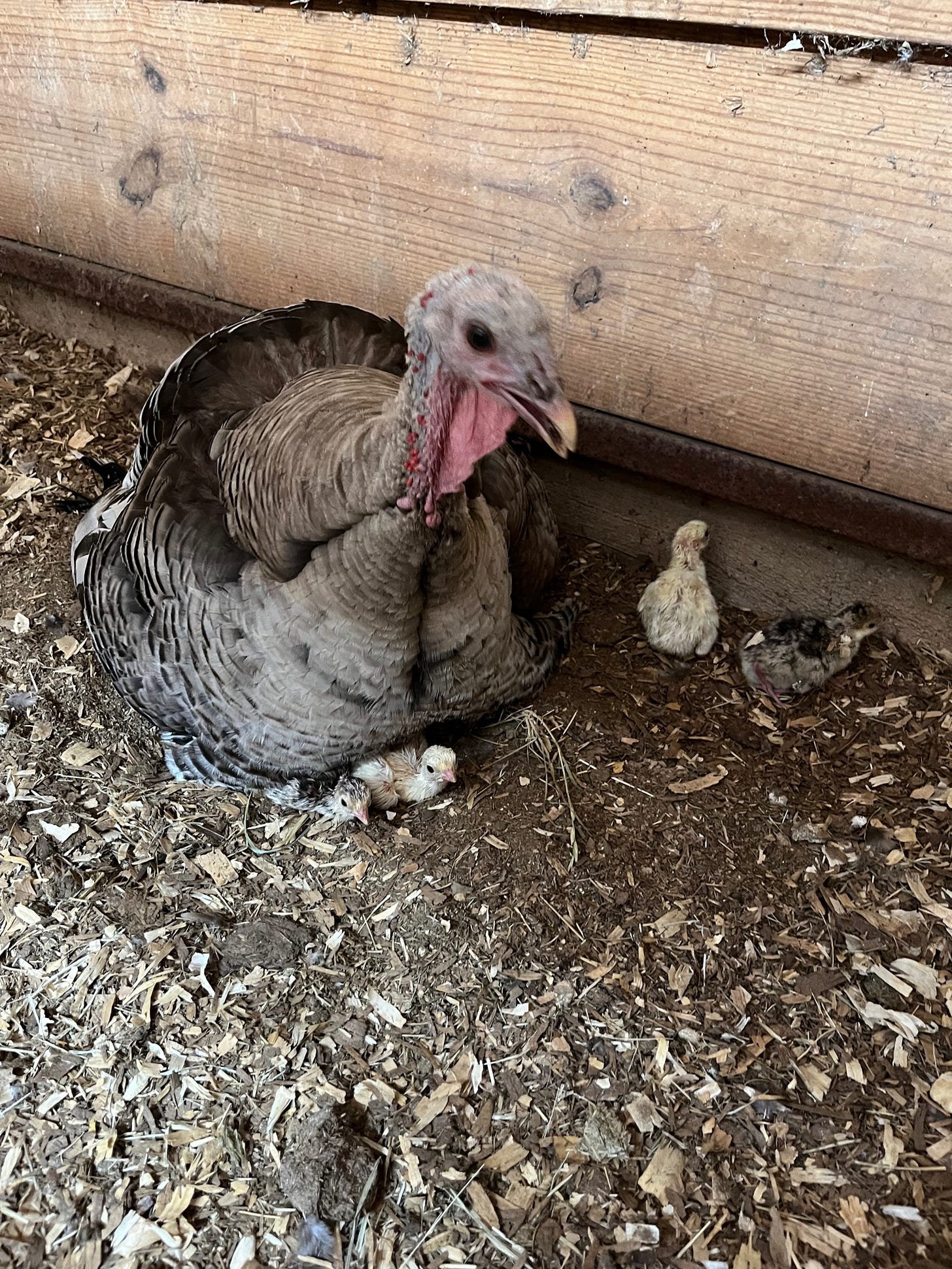
A RP tom on a Narr hen should only produce Narr poults, which told me there were other genes at play here. I bought Bill as a “tom that was a Blue/Bronze mix”. Obviously, a few months later I realized she was not a tom and got Al. Also, ‘mix’ is not an accurate term and didn’t help my genetic predictions. With a lot of tweaking the calculator as well as back-tracking what Bill really is, based on having yellow (RP) poults along with speckled (Narr), I figured genetically she is a Black-Winged Narragansett Semi-Color Semi-Gray (say that fast a couple times and you’re talking turkey!). Her daughter with Al, Bob, is the same genetically and fits the calculator results. She is on the right of this picture with two of her full brothers from the summer hatch, she hatched in April 2023:
This year, Bob has been more successful at laying, brooding and hatching than Bill. She hatched out three ducklings in January and a week ago hatched out two poults and a duckling herself and adopted Nugget, an incubator hatched poult days older:
Based on my preference for their colors and the sex-linked poults that would come from them with Al, I added two hens to my flock in late 2023:
RP tom x Sw hen = sex linked Sw males, RP females.
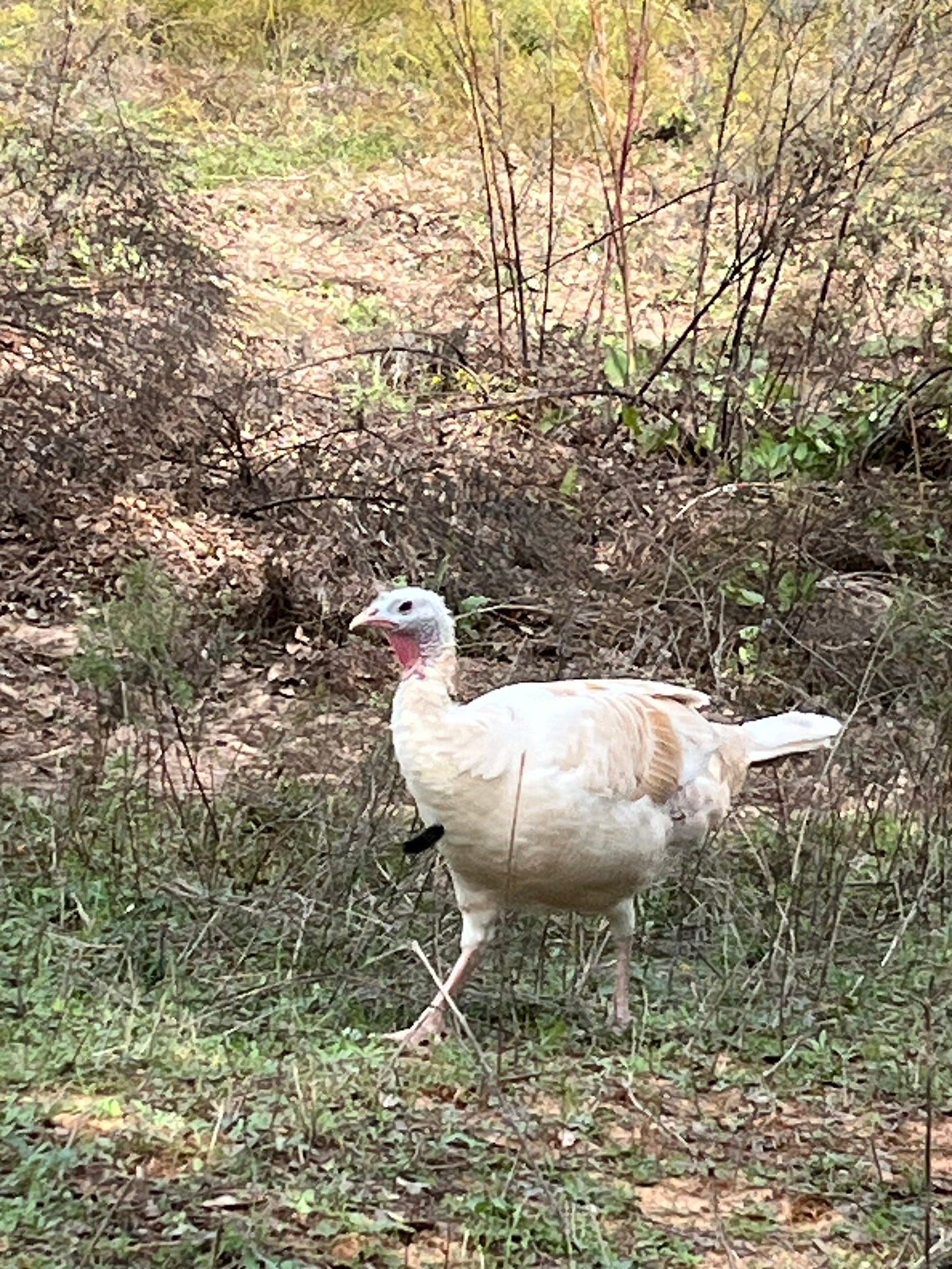
RP tom x LavSw hen = BlueSw males, Blue Palm females.
Ann has had some health issues (lice, wonky feet, unthrifty) and is allegedly three years old+, so I didn’t get any eggs from her for a long time and gave up on that until I found a unique egg amongst my Narr’s and ducks’ [one day I’ll write a strange post about how I can tell almost all of my hen’s eggs apart and how eggshell color is linked to the hen color…stay tuned]. This egg developed and hatched a yellow poult that dna tested as female:
I since found two more of Ann’s eggs and am incubating them despite having cleaned and put away my incubator until September. They are in with predominantly Buff duck and some Cayuga duck eggs, fingers crossed they’ll develop and hatch into something I can study.
Fergus’ eggs hatched a few poults for me in the spring 2024, along with some of Bill/Bob’s. At the time, I still had Moscú, one of Bob’s Narr brothers, and when the poults came along as a mix of speckled and yellow, I suspect he was the tom, as one of her speckled poults dna tested as male:
BWNScSg tom x Sw hen = sex linked Sw and Cornish Palm males, RP and BWNScSg females
Unfortunately, I lost him in the same manner as Tetouan, so wasn’t able to see him develop. Fergus hasn’t begun laying again, but her eggs are easily distinguishable and she loves to lay them in a flowerbed right by the porch, so when it happens again, I’m ready. Her other eggs that hatched dna tested as a male (Sw) and a female (RP). I kept the Sw for my project, Sir Alex Ferguson and a RP female from AlxBill, Maggie Thatcher. I rehomed as a pair an RP tom (AlxBill) and a RP female (MoscúxFergus). This way I could continue my color project without breeding full siblings to eachother. One of the last comparison pictures I took before rehoming was this one below, in which I had some questions specifically about the RP female’s coloring, which appeared to show some gold hints despite being RP. I have not received any answers yet from my turkey color genetics group.
Fergus doesn’t look like a Calico to me, but if that were the case, the possibilities would be:
RP tom x Cal hen = RP, Cal (not sex linked)
BWNScSg x Cal hen = BWNScSg, Cal, Golden Phoenix, RP (not SL)
The only way the top combo is possible is if Sir Alex and Sonora were Calicoes. I think the color difference is too great for that, despite sex differences. So, the bottom more likely combo [Moscú and Fergus were bffs while he was here] would mean that Alex is a Cal or Golden Phoenix, and Sonora perhaps a Cal as well. Same problem as above, except if Alex were a GP and Sonora a Calico. The issue there is, GPs have a very dark base color that Alex does not. So I think the calculator was correct, as was I in identifying the parent colors, but there might be some genes at play that haven’t been fully understood yet or would have to be described in further detail, such as a “dilute Sweetgrass” or something like that.
The thing I overlooked in my zealousness to get sex linked poults was that RPs and Sweetgrass are both yellow when they hatch…uggh. My bad, but they are adorable little things and I enjoy seeing them develop their colors. I also dna test only the turkeys to short change a months-long and possibly wrong process at determining what sex they are (see: my ‘tom’ Bill). My color project involves Palms and Sweetgrasses, but I keep my Narr girls around because they are tough and hardy and really great moms. Bob even got bitten by a snake (copperhead?) on her face while sitting on her eggs in the woods - she was very swollen but also angry at me for moving her eggs and locking her in the barn. She was back to herself in two days - true grit!
Ducks! Yay!
If you’ve made it this far, that’s great, but this part will be really long. I started my ducking journey with Cayugas and am thoroughly pleased with them. But then I started discovering there were other colors! of Cayugas: Blue, Chocolate, etc. and you could sex link ducklings that hatched colors based on what sex they were. A similar color calculator was available for ducks, but with less detail than what has been done on turkeys.
Here’s where the inevitable but, are they pure?? question comes up. The American Poultry Association/APA (the organization) defines Cayugas under waterfowl as a ‘medium duck’ and only as Black (breed standards). Under that definition, other Cayuga colors couldn’t exist either as a breed or a variety because of the Extended black gene. We’ll come back to this.
The APA defines Buff ducks as ‘medium’ as well, but “Only One Variety” as color - what does that mean? Apparently, when you breed Buff ducks they hatch in three different varieties because of the color genes involved. These names are different depending on the organization, but range from Light/Blond to Standard/Buff to Dark/Brown. The color differences are more noticeable in drakes than in ducks. The creator of these ducks also had other colors like Blue and Black, though the Buff coloring was the most popular by far. It is thought that Cayugas and other types of ducks were used to create and define the Buff coloring. That fact and the color variations easily explain how and why other colors are available, especially once you study the specific genes involved.
According to the color calculator, you can get sex linked ducklings at hatch by breeding a Buff drake to a Black duck, which gives Blue males and Lilac females. I found a trio of Buff ducks to add to my flock (one Blond duck, a Blond drake and a Standard drake). These ducks were very similar in body type to my Cayugas, although lighter since they are dual purpose and Cayugas were the premier meat ducks before the popularity surge of the Pekin. I limited myself to medium duck types either to eliminate body types I didn’t want (Call, Pekin, Ancona*, Runner) or color genes I didn’t want to add (Welsh Harlequin, Rouen, Campbell, Magpie).
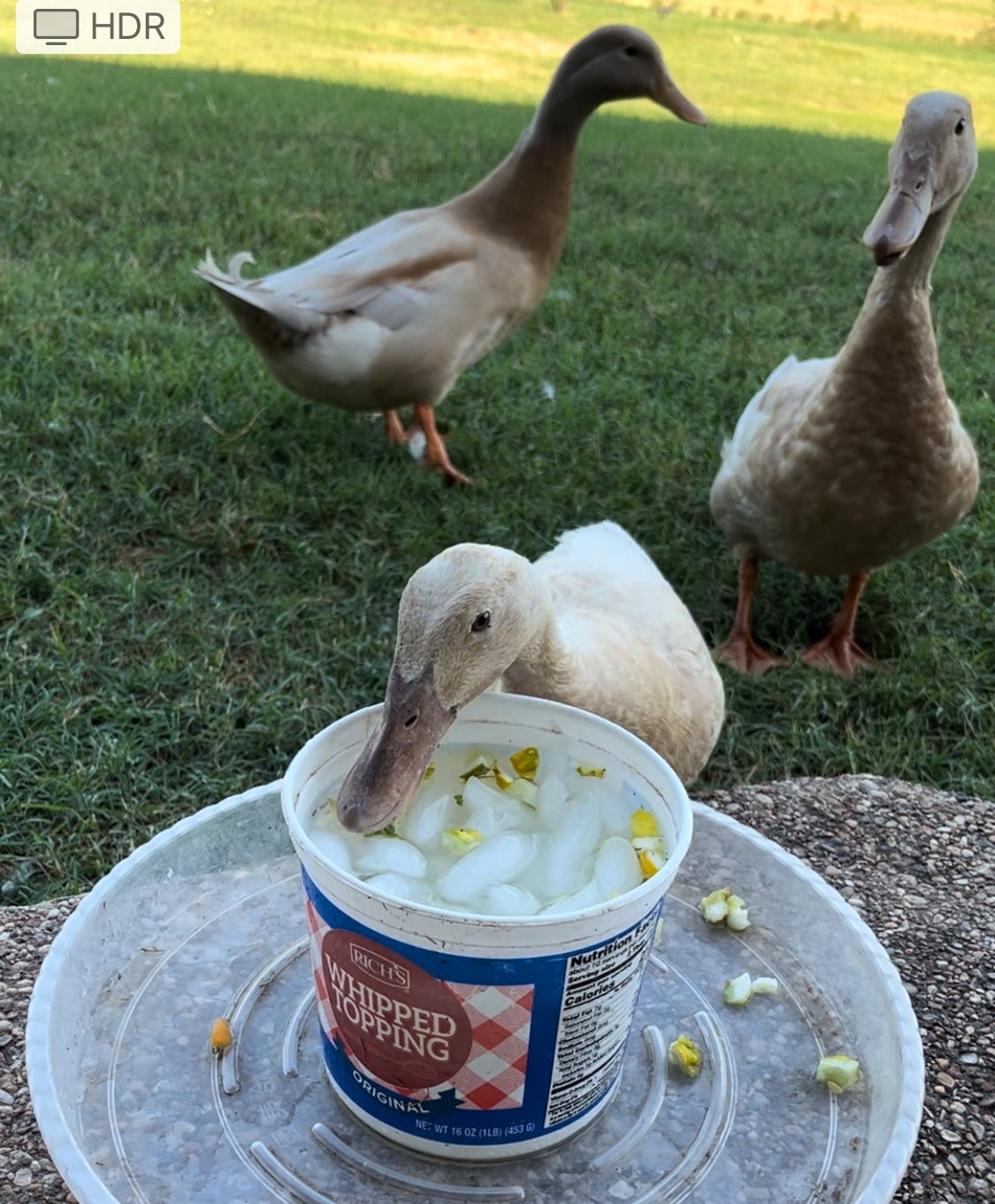
Light Buff drake x Black duck = Blue males, Lilac females (the calculator calls this color Lilac, but I think visually it looks more like Lavender. There is an incredible lack of pictures and details surrounding these colors of adults and ducklings, so I tried to document my experience as much as possible).
Standard Buff x Black = Blue males, Lilac females, Black males or Chocolate females (so same as above, but more options and sex linked).
It wasn’t likely, but drakes are pretty opportunistic, so just in case I calculated what would happen if Getafe found Paella (which did happen! Pics below):
Black drake x Light Buff duck = Blues (not sex linked, but straight run).
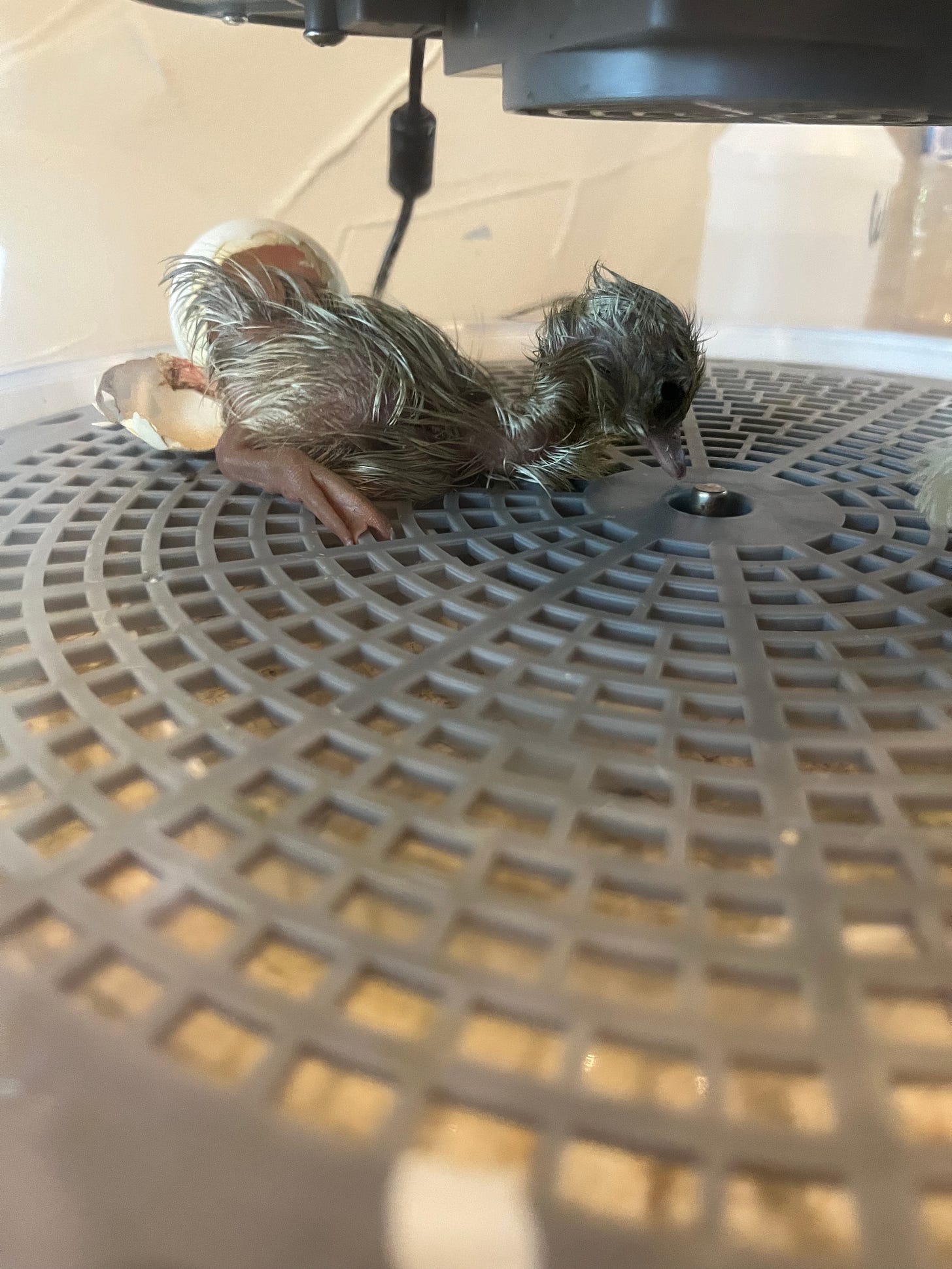
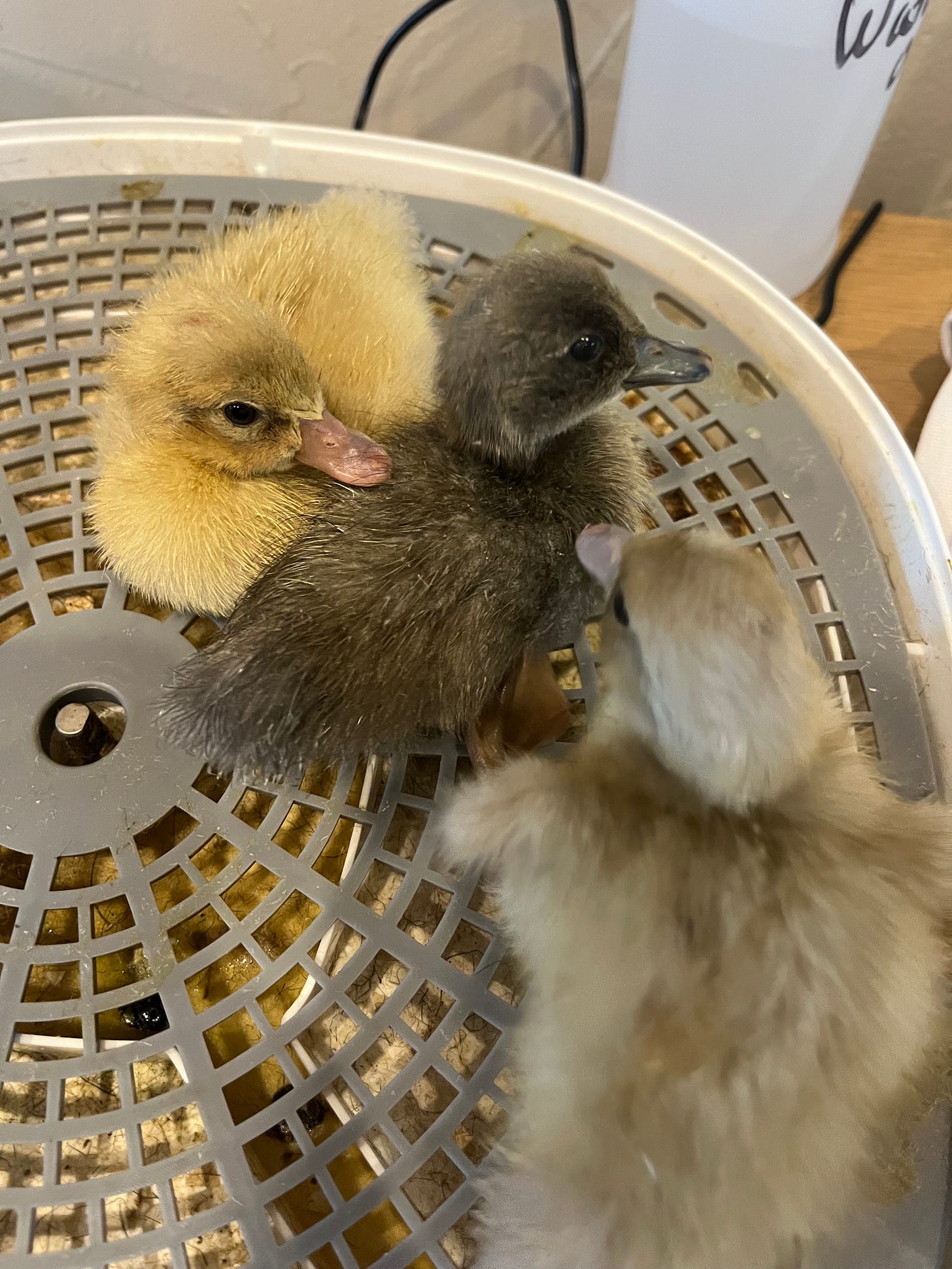
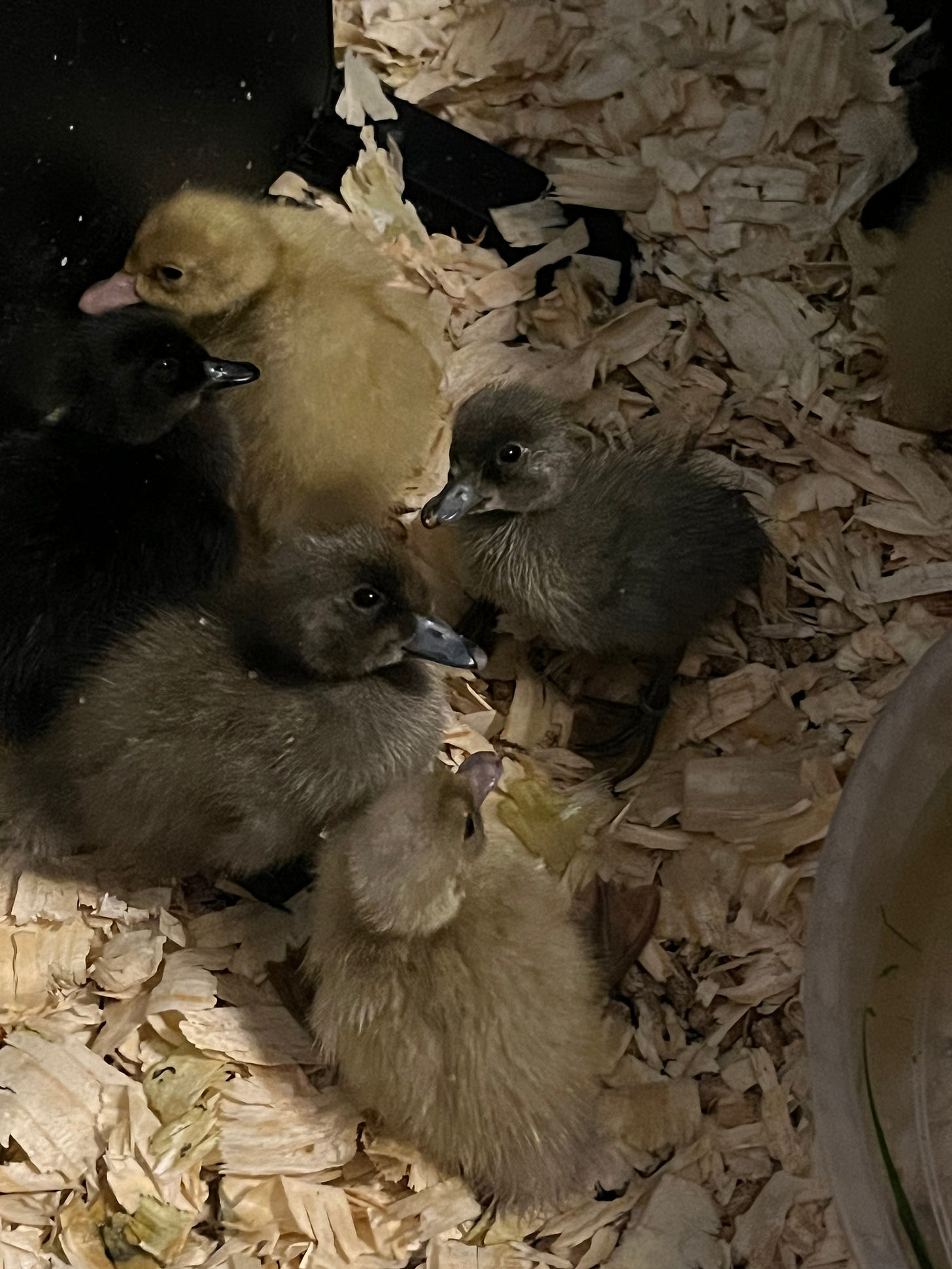
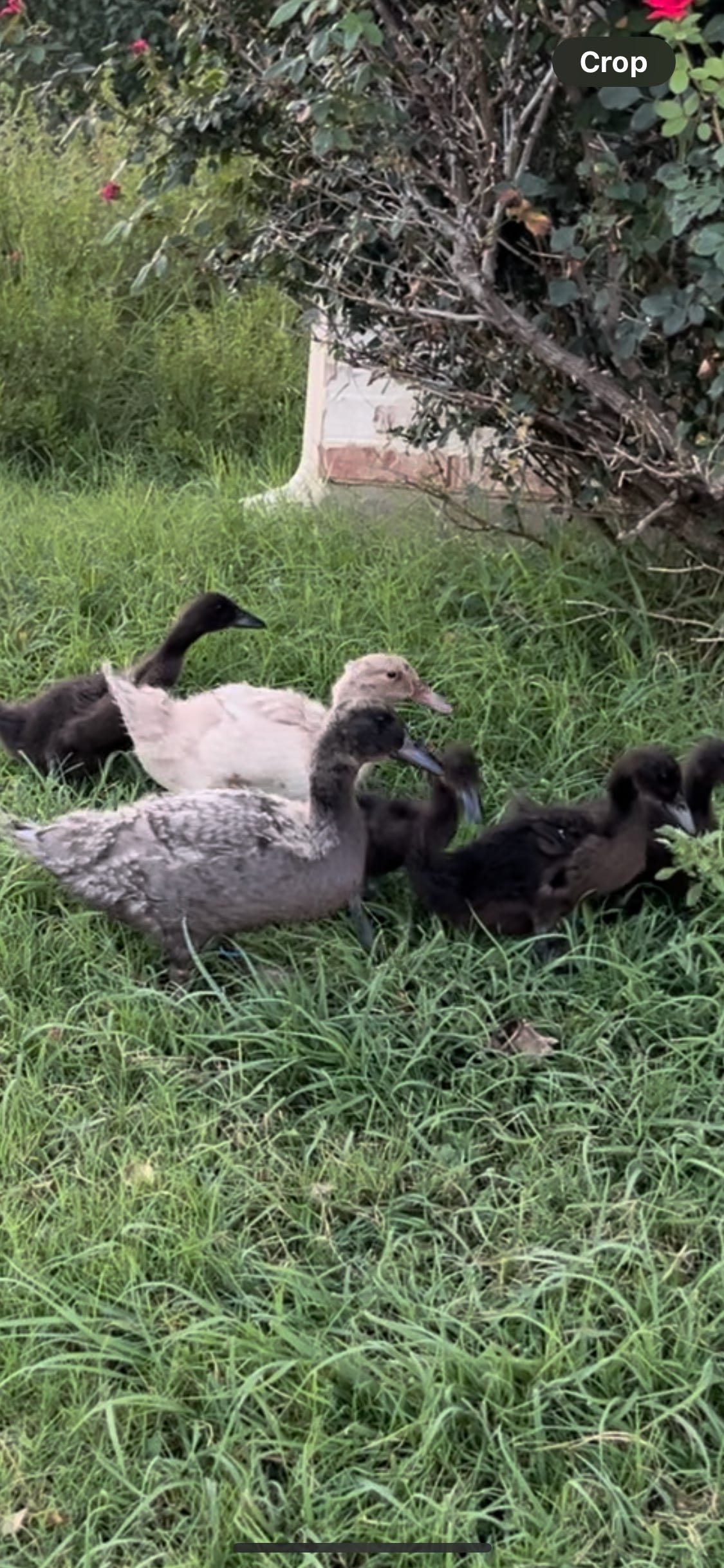
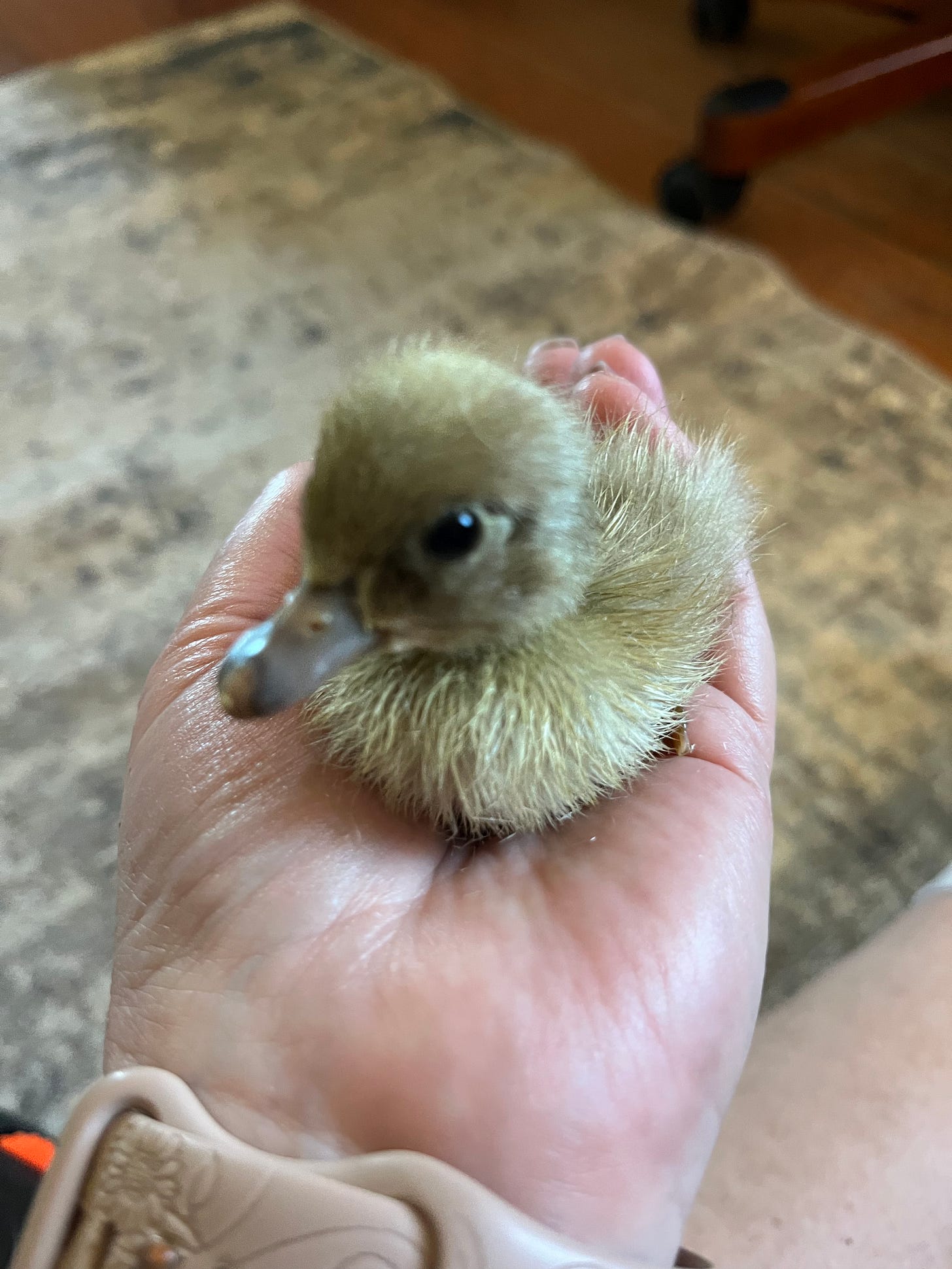
The third component to my duck color project was to add a Crest. The APA recognizes White and Black Cresteds as medium ducks, but I have not been able to locate Black Cresteds anywhere. Buying WCs from a hatchery required minimums and shipping, etc. so I carefully stalked my local feed stores when they would get in shipments of ducklings from their hatcheries. The stores receive ‘assorted’ ducklings which can be a mix of any ducklings the hatchery produces. It was a simple manner to call and ask if any “poofy-headed ducklings” had arrived with the shipment as the clerk could simply look and see. I did this for months until I got lucky. A crest is a sometimes naturally occurring mutation that happens in Mallard-based breeds, never in Muscovies. WC ducks are thought to have descended from crested Runner ducks [called Bali ducks] that were taken back to Europe and bred with white Pekin type ducks. The crest is a patch of feathers that grows from a hole in the skull of the duck**. Some people believe the presence of the crest and breeding for it is unethical, yet these ducks have been around a long time and are present in paintings from the 1700s. A book was published that stated the crest was a lethal gene and ‘killed ducklings in the shell’, however my preferred hatchery has stated that isn’t the case [and besides, if that were true, hatcheries would not make any money off so many ducklings deaths and wouldn’t continue to hatch them]. There are also rumors that these ducks have neurological problems and live miserable lives, but I cannot find actual statistics to back this up. Most people that are fortunate to own Cresteds adore them and I have to say that as they’ve grown, among my ducks they are the most eye-catching, noisy and entertaining ducks. A friend working on our house would refer to them as ‘Einstein ducks’, they are friendly and silly, and there is nothing they love more than getting sprayed with the hose!
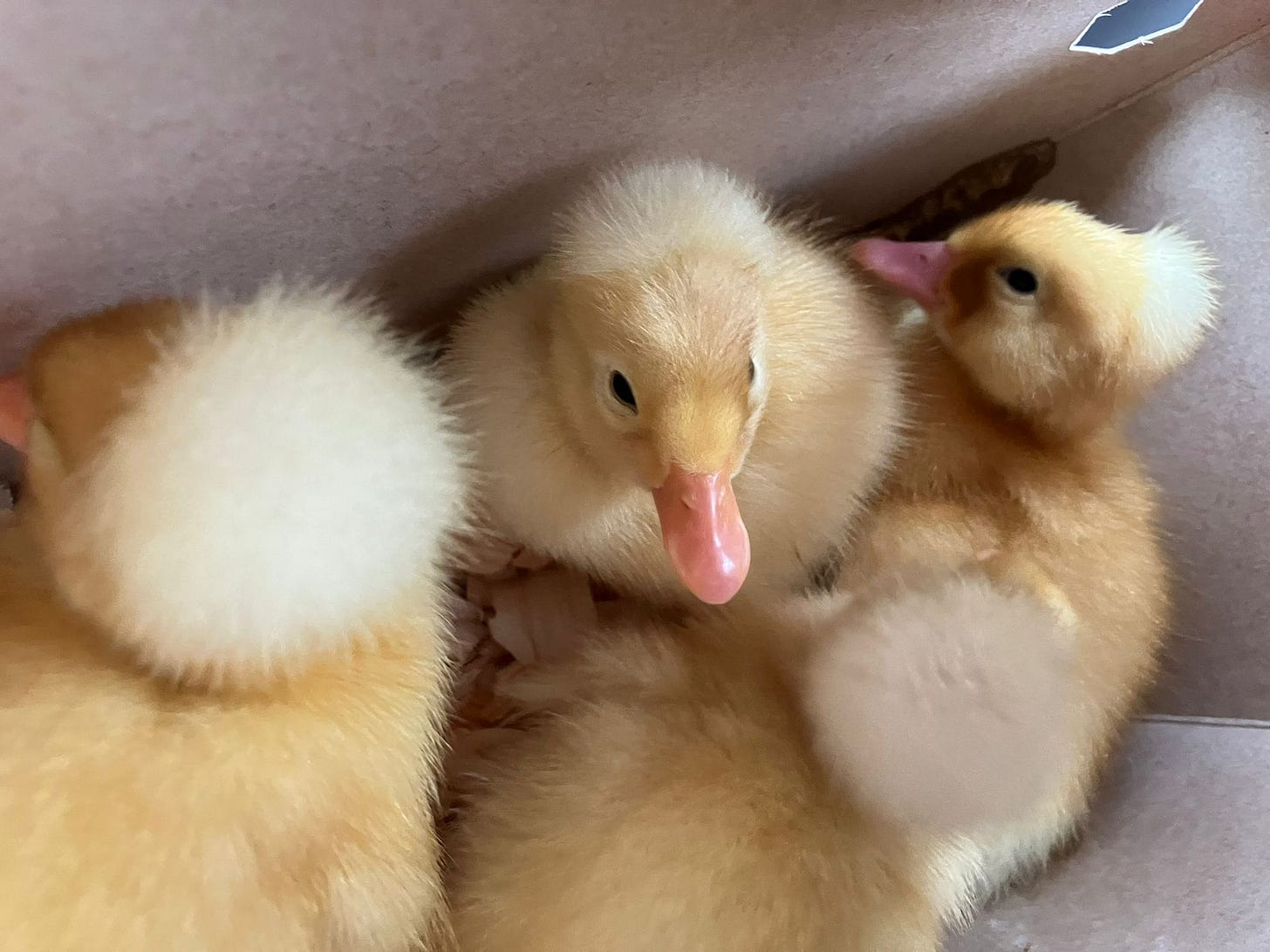
So, on to the details of my color project: for the ducks I have a two-branch project. One branch is to develop a flock of Crested Blue mallards and Crested Apricot mallards [these colors are documented in Call ducks, not really in the medium duck, but that’s what I have to go on]. A flock of these colors would ‘breed true’ in that they would produce only BMs and AMs. Alongside color, these ducks would also have to function in a homestead setting: free range for plants and bugs, not fly away and be predator-wary. These characteristics are dependent on husbandry and setting, but it’s important to me to state that color alone will not be the basis for breeding lines. Ducks that seem weaker, health/leg or weight issues, flighty or aggressive personalities despite their color will not be selected.
The second branch is to develop? reinvigorate? redevelop? a solid Black Crested medium weight duck. I have a couple routes to get there, but it requires careful distillation of these three base gene sets and time to allow for breeding cycles. Ducks reach sexual maturity at about five months, but I likely will wait an extra month to incubate eggs to allow the ducks time to get it right.
The first important cross will be
Standard Buff drake x WC duck = Blue Mallard(c) and Mallard(c) males, Lilac Mallard(c) and Chocolate Mallard(c) females. The (c) denotes crested genes, even without visible crest.
The BM and M males from here can be bred to Buff females to produce BM, AM and Mallard straight runs. I’m currently incubating a lot of Buff eggs and will select females to keep in the project. There’s always the chance of Blue SRs and more Blue/Lilac SL from the handful of Cayuga eggs I added to the incubator. Knowing which duck laid the eggs and careful identification [of both egg and duckling after hatch] combined with excellent record-keeping have allowed me to be almost obsessive about documenting my experience.
The females from here form the second branch:
Black drake x LM(c) duck = Blue Bib(c), Black Bib(c), Blue(c), Black(c)
The Bib gene is not one I would like to include in my project, however, these are basically Swedish ducks but with a Crest and still great homesteading ducks. I don’t think I’ll have trouble rehoming these ducks between their beauty and usefulness.
Here’s where my SR Blue drake, Inter, comes into play (and how I justified keeping him in my project, not like I needed to]:
Blue drake x CM(c) duck = Blue(c), Black(c)
Not that my ducks get fed bread ever, but maybe in the next year, I will post about my purebread Martian Black Crested duck:
Resources:
Labradoodle creator regrets it
The turkey color calculator
Good descriptions of turkey colors: Porter’s and this list with genotypes for the calculator
Mallard-based duck color genetics [long but very informative]
The duck color calculator. If there isn’t a preset menu option, create the color you want with the correct parents and select “Continue with this _”
Cayuga colors info by the same author, in an article and his website [for info only, no ordering is available]
APA waterfowl info
Buff Orpington duck history and color info
*Ancona ducks are not recognized by the APA at all, even though they are an established ‘breed’ with many color combos possible. A friend of mine with an egg production business prefers Anconas and can tell his large flock apart just from the individual color patterns. Here’s an interesting take on the APA Ancona issue.
**Of the four ducklings I purchased, only one seemed to have issues. At first I thought it was blindness and maybe deafness, but it had adapted well to rely on its duckling siblings for safety and getting to food and water. It would swim and act just like the others except sometimes it got left behind and would call loudly for them. Unfortunately it developed a tremor which would cause it to curl its neck under. I tried stretching and massaging the neck muscles to loosen them, but was concerned about quality of life combined with the lack of sight and being able to free range with the others safely. I ended up having to cull this one, but carefully dissected and studied the crest and the hole in the skull. The hole was there and considerably sized, but I think the issue was being caused and worsening by some of the brain tissue growing outside and around the edges of the hole, possibly getting squeezed in the process as the duck grew. I am not sure if this hole is completely present throughout the duck’s life, or in that size, or is a defect that occurs before hatch and heals/closes/gets smaller with age. I have not found research or photos that address this issue, so will commit to doing my own as much as possible out of respect for the ducks.



